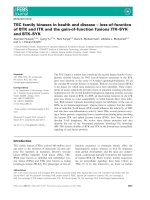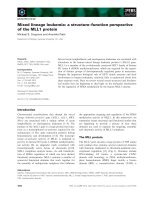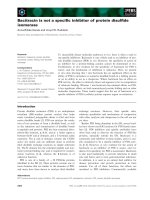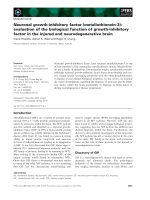Tài liệu Báo cáo khoa học: Bone morphogenetic proteins in the early development of zebrafish pptx
Bạn đang xem bản rút gọn của tài liệu. Xem và tải ngay bản đầy đủ của tài liệu tại đây (616.61 KB, 8 trang )
MINIREVIEW
Bone morphogenetic proteins in the early development
of zebrafish
Mariko Kondo*
Department of Biological Sciences, The University of Tokyo, Japan
Introduction
Bone morphogenetic proteins (BMPs), now widely
known for their involvement in many biological pro-
cesses, were first described for their bone morpho-
genetic activity, and thus were given their names. Four
proteins were initially identified, and one of them,
BMP1 is a metalloproteinase. The other three (BMP2,
3 and 4) are members of the transforming growth fac-
tor b (TGF-b) superfamily of secreted signaling mole-
cules. Subsequently, molecular cloning studies have
identified more than 20 members of the BMP sub-
group in the TGF-b family, from various species.
Examples of these members are decapentaplegic (Dpp)
and 60A from Drosophila, Xenopus Vg1, and BMP5-7.
Although it is not known whether all of the members
of this subgroup are involved in bone differentiation,
they control a wide range of biological processes in
various cell types, such as differentiation, cell prolifer-
ation, migration, and apoptosis.
The signaling cascade of BMPs has been inten-
sively studied, and the players have been identified
to a great extent (Fig. 1). Signals from BMPs are
mediated by BMP receptors, which also comprise a
gene family, the TGF-b receptor family. Functionally
active BMPs form dimers, which are secreted and
bind to the type I and type II receptors on the cell
surface. These receptors are serine ⁄ threonine kinase
receptors with a single transmembrane domain. Bind-
ing of the ligand to the receptor complex induces
the type II receptor to phosphorylate the type I
receptor, which then leads to activation of the type I
receptor. The signal is passed on to the substrates of
the type I receptor kinase, receptor-activated Smad
proteins (R-Smads, Smad1, -2, -3, -5 and -8), which,
upon phosphorylation, are activated and bind to a
common mediator Smad (Co-Smad, Smad4).
The complexes move into the nucleus and act as
regulators of transcription. The activity of BMP is
regulated by the binding of extracellular inhibitors.
The roles and functions of BMPs in embryogenesis,
from insects to mammals, mostly during the early sta-
ges, have attracted the interest of many scientists. In
this review, I mainly focus on the recent findings using
Keywords
bone morphogenetic protein (BMP);
dorsoventral patterning; embryogenesis;
zebrafish
Correspondence
M. Kondo, Graduate School of Frontier
Sciences, The University of Tokyo,
Chiba, Japan
E-mail:
(Received 30 November 2006, accepted
27 February 2007)
doi:10.1111/j.1742-4658.2007.05838.x
Bone morphogenetic proteins (BMPs) are known to be widely involved in
various biological processes. Many of the members of the BMP family, as
well as related factors, receptors and molecules in the BMP signaling path-
way, have been isolated, but their precise functions are still unclear. In
addition to the ‘classical’ model organism Xenopus, zebrafish, Danio rerio,
is now considered to be a suitable model organism to study the roles of the
BMP signaling pathway during embryogenesis. Mutagenesis screens have
identified a number of mutants in the pathway. Although they do not cover
the entire members of the BMP signaling cascade that are currently known,
they serve as a powerful tool to broaden our understanding of BMP func-
tions, in combination with other experimental techniques.
Abbreviations
ADMP, anti-dorsalizing morphogenetic protein; BMP, bone morphogenetic protein; TGF-b, transforming growth factor b.
*Correction added after online publication 22 May 2007: An author name has been removed at the request of the individual.
2960 FEBS Journal 274 (2007) 2960–2967 ª 2007 The Author Journal compilation ª 2007 FEBS
zebrafish, Danio rerio . Zebrafish has established the
position as a major model species for early develop-
mental studies during the past decade. With zebrafish,
large-scale mutagenesis screens have been performed,
strains carrying mutation for genes involved in early
development have been identified, and much know-
ledge, mostly about the function of genes and the rela-
tionships among them, is being accumulated.
Members of the BMP family
in zebrafish
The roles of BMP proteins in mesoderm induction and
dorsoventral patterning have been studied in detail
using Xenopus [1]. Xenopus bmp2, bmp4 and bmp7 tran-
scripts are maternally expressed. bmp4 is expressed in
the ventral marginal zone during gastrulation but is
excluded from the organizer region, and is considered
to play the major role in specifying dorsal–ventral struc-
tures. Techniques such as animal cap assays and
mRNA injection, and, recently, morpholino knock-
downs, have been and are the major tools for identifica-
tion and functional assays of BMPs. Knockdowns of
bmp2, bmp4 and bmp7 by morpholino injections into
embryos result in mild dorsalizations, and of these three
BMP proteins, BMP4 seems to be the most effective [2].
Members of the zebrafish BMP family involved in
early embryogenesis have been likewise identified. In
zebrafish, two bmp2 genes, bmp2a and bmp2b, bmp4
and bmp7 are expressed as early as 4 h after fertiliza-
tion, in the sphere stage [3–5]. Expression patterns of
bmp2 and bmp4 in general show high conservation to
those homologs of mouse and Xenopus [6,7]. Zebrafish
bmp2b and bmp4 are expressed in the ventral regions
in gastrula embryos, indicating the involvement in
regulation of dorsoventral patterning, whereas bmp2a
cannot be detected by in situ hybridization. To be
more precise, bmp2b is expressed in the presumptive
mesoderm region exclusive of the embryonic shield
but, in contrast, bmp4 is expressed at a low level in the
embryonic shield (Fig. 2). Therefore it is likely that
zebrafish bmp2b rather than bmp4 may be functionally
homologous to Xenopus bmp4. Indeed, judging from
the expression pattern in the shield, which corresponds
to the Xenopus organizer, and from further studies
using zebrafish mutant strains, it has been proven that
bmp2b possesses ventralizing activity [8], like bmp4 of
mouse and Xenopus.
Zebrafish bmp7 was identified through the analysis
of the mutant snailhouse (snh) (discussed below). bmp7
is expressed also like bmp2 and bmp4, from the sphere
stage on [5,9]. At the sphere stage, bmp7 is expressed
Fig. 1. Schematic drawing of the BMP signal transduction pathway.
Extracellular BMP dimers bind to the type I and type II BMP receptor
complexes at the cell membrane. The BMP type II receptor phos-
phorylates the type I receptor, which transduces the signal by phos-
phorylating an R-Smad protein. The phosphorylated R-Smad binds
with a Co-Smad, and the complex is translocated into the nucleus,
where it activates transcription of target genes. P, phosphorylations.
Fig. 2. Expression domains of bmp genes and genes involved in
BMP signaling. Expression of mRNA at shield stage is denoted by
the shaded area. The drawings are based on data from whole
mount in situ hybridizations [9,13–15,19]. All embryos are shown
from the lateral view, with dorsal to the right.
M. Kondo BMPs in the early development of zebrafish
FEBS Journal 274 (2007) 2960–2967 ª 2007 The Author Journal compilation ª 2007 FEBS 2961
in the entire blastoderm except for the dorsalmost
regions where the organizer will form. At shield stage,
a graded expression is observed, with a high expression
in the ventral half of the embryo (Fig. 2).
Anti-dorsalizing morphogenetic protein (ADMP)
[10] is another member of the BMP family. The admp
transcripts are, unlike other bmps, expressed dorsally
in the zebrafish organizer region. Contradictory to its
dorsal expression, overexpression induces loss of dorsal
fates, and likely acts as an antagonist of organizer
function and inhibits head formation and promotes
trunk formation [10]. Although admp may cooper-
ate with bmp2b or bmp7 in establishing dorsoventral
regionalization, ADMP appears to act through a
different signaling pathway because, although the
phenotypes from overexpression of these genes are
similar at early stages, they are completely different at
later stages [11].
BMP antagonists
Dorsal development in Xenopus embryos is carried out
by secreted peptides synthesized in the Spemann
organizer, namely Follistatin, Chordin and Noggin
[12]. These proteins are antagonists of BMP and other
members of the TGF-b family, binding to and inhibit-
ing these signaling molecules from binding to their
receptors in the extracellular space, thus inhibiting ven-
tralizing activities. Of these proteins, Chordin has a
long-range effect. In Xenopus, expression of the chordin
gene is localized to the dorsal marginal zone, but the
protein is considered to diffuse laterally and ventrally,
in a graded manner, hence producing a gradient in
BMP activity in the marginal zone.
Similarly, zebrafish chordin [13], follistatin [14] and
noggin [15] genes have been isolated. These genes,
when experimentally overexpressed in the embryo,
cause dorsalization of the embryo. chordin,asinXen-
opus embryos, is expressed in the dorsal embryonic
shield [13] (Fig. 2), which corresponds to the organizer
region in frog. In addition, the transcripts are detected
in additional regions, such as paraxial mesoderm and
ectoderm, which is different from what is observed in
Xenopus. Three noggin homologs were identified [15],
named noggin1, 2 and 3, and show different expression
patterns, but have dorsalizing activities. noggin1 is the
earliest of these noggin genes to be expressed in the
embryo, and its transcripts are found in the organizer
of gastrula embryos, later in the prechordal plate and
axial mesoderm (Fig. 2). By contrast, noggin2 tran-
scripts are detected at the end of gastrulation in the
axial mesoderm, and noggin3 transcripts are limited to
chondrogenic regions, and are not expressed in the
organizer. Nevertheless, these three gene products have
similar biological activities, being able to antagonize
BMPs. The expressed regions combined together, cor-
respond to that of single-copy noggin homologs in
other vertebrates, and could be explained as reflecting
the additional genome duplication and subfunctionali-
zation of the genes in teleosts. follistatin displays an
expression pattern clearly different from Xenopus:itis
not expressed in the organizer [14]. It is not detected at
early gastrula stages but is detected first at 60%
epiboly, in dispersed presumptive mesodermal cells
located in the hypoblast (Fig. 2), and then the paraxial
expression domain expands, although excluded from
anterior axial regions. This indicates that follistatin is
not involved in organizer activity, different from the
Xenopus homolog, but resembles the mouse homolog,
which is also not present in the organizer. BMP inhib-
iting activities in other domains or during later stages
of dorsoventral patterning is more likely to be the bio-
logical function of zebrafish Follistatin.
BMP mutations affecting dorsoventral
patterning
Large-scale mutagenesis screens in zebrafish has been
utilized for identification of genes essential for early
embryogenesis [16], and a number of mutants with
defects in dorsoventral patterning have been identified.
Figure 3 shows examples of mutants with either dor-
salized (C1–C5) or ventralized (V1–V4) phenotypes [8].
Of those mutant strains isolated from mutant screens,
swirl (swr) and snailhouse (snh) [17] were identified as
being mutants for bmp2b [8] and bmp7 [5,9], respect-
ively. The swirl (bmp2b) mutant is severely dorsalized
(C5 phenotype; Fig. 3), and lacks ventral structures,
but the paraxial mesoderm and the neuroectoderm are
expanded. This demonstrates that bmp2b is required
for early dorsoventral patterning. BMP2 functions to
maintain its expression in ventral regions during gastr-
ulation, and also maintains bmp4 expression, thereby
Fig. 3. Morphologies of normal (N), dorsalized (C1–C5) and ventral-
ized (V1–V4) embryos, adapted from Kishimoto et al. [8]. V1 and C1
embryos are weakly ventralized or dorsalized, respectively, and the
strongest phenotypes are V4 and C5.
BMPs in the early development of zebrafish M. Kondo
2962 FEBS Journal 274 (2007) 2960–2967 ª 2007 The Author Journal compilation ª 2007 FEBS
the expression is autoregulatory. snailhouse (bmp7)
mutants show slightly weaker dorsalization (C4 pheno-
type) compared to swirl, although the snh
ty68
mutant is
temperature sensitive and displays a stronger pheno-
type at 33 °C than at lower temperatures, and the aub
mutant is a stronger allele of snh and shows the C5
phenotype. Interestingly, bmp2b and bmp7 are only
required during embryogenesis, as transient mutant
embryos rescued during embryogenesis develop into
adulthood and bred [5,18]. swr, snh double mutants
are not stronger in phenotype compared to single
mutants, indicating that bmp2b and bmp7 function
in the same pathway, possibly as heterodimers [9],
because the coinjection of bmp2b and bmp7 into the
same blastomere, opposed to separate injections in
adjacent cells, results in stronger ventralization of the
embryo.
BMP pathway analyses using zebrafish
mutants for bmp genes
The somitabun (sbn) mutant, which is strongly dorsal-
ized, is caused by the mutation in smad5, a signaling
molecule in the BMP pathway [19]. The sbn
tc24
muta-
tion is both dominant maternal (causing strong C4
dorsalization) and dominant zygotic (weak C1 dorsal-
ization). The phenotype is rescued by smad5, bmp2b
and bmp4. The early expression of bmp2b in sbn is
not affected, but that in early gastrula is severely
reduced. This expression also is rescued by smad5,
showing that the autoregulatory maintenance of
bmp2b expression is mediated by smad5. The sbn
phenotype is also rescued by human smad4 RNA
injection. Thus, the interaction with Smad4 could
account for the sbn mutant phenotype. In addition,
the loss of smad5 activity might lead to the inhibition
of other Smads, such as Smad1, involved in the
Smad signaling pathway, and also lead to the pheno-
type. Overexpression of smad1 and smad5 by mRNA
injection into wild-type embryos resulted in ventrali-
zation (causing up to V4 phenotypes), with smad1
being more effective than smad5 [20]. smad5 mRNA
injection rescues sbn and snh (bmp7), but not swr
(bmp2b). By contrast, smad1 rescues swr. smad1 is
expressed ventrally in gastrula as is bmp2b, and the
expression is expanded dorsally and at a higher level
by bmp2b overexpression, but is lost in swr embryos,
and strongly reduced in sbn embryos. There is a dif-
ference between smad1 and smad5 expression, which
may cause the difference in function. Smad5 acts very
early in development, and its mRNA is supplied
maternally and expressed throughout the embryo at a
basal level (Fig. 2), whereas smad1 transcripts are
only detected from 80% epiboly. As sbn and swr
[17], and sbn and snh [5], interact genetically, the
bmp2b and bmp7 signals should converge at the level
of Smad5 [5]. Based upon these observations, a
model for dorsoventral patterning in three phases is
suggested [5,19,20]. In the first phase, likely by mater-
nal components, the organizer is induced and the ini-
tial dorsoventral pattern is set up. bmp2b expression
is initiated. The putative dorsoventral BMP gradient
is set up in the second phase, where bmp2b expres-
sion is maintained through a positive feedback by
BMP2B itself and Smad5, but BMP is inhibited by
Chordin from the organizer. During this phase,
smad1
starts to be expressed. smad1 is also positively
autoregulated. bmp7 is also required in this phase to
establish the BMP gradient. In the third phase,
dorsoventral patterning is carried out by BMP signa-
ling, which is mediated by Smad1. By contrast to the
second phase, dorsoventral patterning is independent
of Smad5 and BMP7.
The BMP morphogen gradient established along
the ventrolateral axis is explained to induce different
cell types [18]. The morphogen concentration is high
in the ventral and lower in the dorsal domain. The
steepness of the gradient is determined by how much
BMP there is available. The different concentration
induces differential gene expression according to the
threshold needed for induction and leads to cell dif-
ferentiation. Depending on the threshold, the dorso-
ventral position and quantity of a certain cell type is
determined. In swr embryos, no gradient develops due
to the lack of bmp2b (morphogen). sbn embryos have
a low, and snh embryos have a moderate, morphogen
concentration. Therefore, in these mutants, the
morphogen gradient is less steep than wild-type
embryos, and not sufficient to induce genes at the
normal position and quantity in the embryo or can-
not induce these genes at all, thus resulting in mutant
phenotypes.
There is only one report of a mutant strain of the
BMP receptor. The dorsalized mutant lost-a-fin (laf)
(C2 phenotype) is a mutant of the alk8, the gene cod-
ing a member of the ALK1 subgroup of BMP type I
receptors [21,22]. This mutant could not be rescued by
overexpression of bmp2b or bmp7, but could be
rescued by smad5. Moreover, alk8 mRNA injected
wild-type embryos developed normally, whereas the
constitutive active version of the receptor induced
strong ventralization (V4 phenotype) [22], resembling
the bmp2, bmp4 or bmp7 overexpressed embryos
[4,5,9]. These show that ALK8 acts as a BMP2B ⁄ 7
receptor, and that Smad5 is positioned downstream of
this pathway of dorsoventral patterning.
M. Kondo BMPs in the early development of zebrafish
FEBS Journal 274 (2007) 2960–2967 ª 2007 The Author Journal compilation ª 2007 FEBS 2963
Mutations in BMP regulators
Mutation in the BMP binding protein Chordin causes
the dino mutant [23,24]. dino mutants show a ventral-
ized phenotype (V2), with a small head and a large
tail. Other ventral and posterior structures are also
enlarged and gene expression is altered: for example,
gata2, which is normally expressed in the ventral half
of the animal region, is expressed much broader and
stronger. The generation of dino-swirl mutant [25]
showed that swirl (bmp2b) is epistatic to dino (chordin).
This is in agreement with the function of Chordin as a
suppressor of BMP.
Tolloid is a metalloprotease that acts to cleave
Chordin, and to inhibit its activity. In Xenopus,itis
considered to counteract the negative regulation of
BMP by Chordin. The tolloid gene product of zebra-
fish was also shown to possess Chordin cleavage
activity [26]. The transcripts are detected throughout
the early gastrula stage embryo but toward the end
of gastrulation, the accumulation of transcripts
around the blastopore and expression in the ectoderm
flanking the anterior neural plate is detected. mini fin
(mfn), the mutant for tolloid-like 1 (tll1, renamed
from tolloid, tld ), show a very weak dorsalized phe-
notype (C1) [17], although the allele strengths differed
[27]. Analyses using swr or din mutants revealed that
tld (tll1) gene expression is positively regulated by
bmp2b and negatively by chordin. In some mfn
embryos, chordin expression is expanded posteriorly
and laterally, but not always in all mutant embryos.
The wide range of mfn phenotype may be caused by
the degree of chordin expression. Nevertheless, Tld
(Tll1) positively regulates bmp4 and tld (tll1) (itself),
and negatively regulates chordin. Taken together with
the autoregulatory expression of bmp2b and bmp4,
these factors form a transcriptional feedback regula-
tory loop.
Although Tld (Tll1) is involved in regulating BMP
expression and BMP activity, mini fin mutants show a
relatively weak phenotype, and no effects on dorsoven-
tral patterning could be observed. This makes it poss-
ible to think that Chordin cleavage may not be so
important, but there is evidence for the redundancy in
cleavage enzymes, and Chordin is cleaved in mfn [28].
Moreover, subdorsalizing knockdown of Tsg (twisted
gastrulation, tsg) by a low dose of tsg-MO induces a
stronger phenotype of mfn (C3), indicating that Tld
(Tll1) also functions to pattern dorsoanterior struc-
tures [29].
Twisted gastrulation (Tsg), a BMP-binding protein,
initially found in Drosophila, is involved in dorsal–
ventral patterning, The role of twisted gastrulation
is not clearly understood because there are reports
on its functions in opposite directions in the BMP
pathway.
The function of Tsg as a BMP antagonist is repor-
ted to be conserved in Xenopus and zebrafish [30–32].
Injection of antisense morpholino against tsg1 blocking
the Tsg function weakly ventralizes zebrafish embryos,
whereas overexpression of tsg1 mRNA dorsalizes
embryos [31]. Tsg inhibits BMP activity synergistically
with Chordin, as shown by the enhancement of ventral
features caused by coinjection of subinhibitory doses
of morpholinos against these two factors [31]. Accord-
ing to Ross et al. [31], there are three molecular func-
tions of Tsg: (a) synergistic inhibition of BMP by
forming a tripartite complex between Tsg, Chordin
and BMP; (b) enhancement of the Tld ⁄ BMP-1 medi-
ated cleavage rate of Chordin, which may change the
preference of site utilization; and (c) promotion of the
dissociation of Chordin cysteine-rich (CR)-containing
fragments from the ligand. They suggest that the first
of these three is the primary function in zebrafish.
The function of Tsg as a BMP agonist has also been
reported [29,33]. Tsg is considered to ventralize Xeno-
pus embryos by blocking the CR1 domain of the Chor-
din protein that blocks BMP. Tsg competes with
CR-1, but not full-length Chordin, to bind BMP, and
releases BMP, forming a complex between BMP and
Tsg [33]. In zebrafish, knockdown experiments with
tsg-MO resulted in moderately to moderately strong
dorsalization (C3–C4) [28,29] by contrast to the previ-
ous study [31] that reports ventralization. Quite sur-
prisingly, with higher doses of Tsg, again, embryos are
dorsalized (C1–C3) [28]. In the low-dosage injected
embryos, chordin expression is expanded laterally [29].
The dual activities of tsg was also shown from injec-
tion experiments into ventralized dino or sizzled
mutants, where partial rescue of the phenotype was
observed upon either tsg-MO or tsg mRNA [29].
In another study, chordin mRNA injection with tsg-
MO injection resulted in an increase of rescued dino
embryos compared to without tsg-MO [28]. Thus, Tsg
decreases the effectiveness of Chordin as a BMP inhib-
itor. swr heterozygous embryos, which normally are
phenotypically wild-type, are dorsalized (C1–C4) with
a subdorsalizing dose of tsg-MO (less that that
required for dorsalizing wild-type embryo), suggesting
the interaction of Tsg with BMP2B for dorsalization
[29]. The ventralizing activity of Tsg is not completely
Chordin dependent because, as mentioned above, the
ventralized phenotype of din mutants could be partially
rescued by tsg-MO injection [29].
According to the model proposed by Larrain et al.
[34], based mainly on studies from Xenopus, Tsg acts
BMPs in the early development of zebrafish M. Kondo
2964 FEBS Journal 274 (2007) 2960–2967 ª 2007 The Author Journal compilation ª 2007 FEBS
in two steps, first by binding to BMP and forming a
ternary complex with full-length Chordin, thus inhibit-
ing BMP to bind to its receptor. When this complex is
cleaved by Tolloid (in the case of Xenopus, Xolloid),
Tsg is able to free BMP from the Chordin complex
and to destabilize the Chordin proteolytic products
that still possess anti-BMP activity, thus functioning to
enhance BMP signaling [34]. The involvement of other
unidentified factors in this process is also suggested
[28,29,35]. The debate regarding the function of tsg in
the BMP pathway probably will remain unresolved for
some time.
Other factors affecting the BMP
pathway
Factors inhibiting BMP2b, other than direct binding
proteins such as Noggin and Chordin, also affect
dorsoventral patterning. One example is found from
the mutant bozozok (boz) with a mutation in the
homeodomain protein coding dharma ⁄ nieuwkoid gene
[36]. In wild-type embryos, bmp2b is first expressed
ubiquitously in the blastoderms but just before gastru-
lation, the transcripts disappear from the dorsal side.
However, in boz mutants, this clearing of bmp2b tran-
scripts does not happen, and the expression is detected
in the dorsal margin and dorsal yolk syncytial layer
[37]. Misexpression of dharma mRNA reduced the
level of bmp2b expression, thereby indicating that
dharma is responsible for the bmp2b down-regulation
in pregastrula embryos. The level in which dharma
regulates bmp2b is not yet clear.
sizzled is the gene responsible for the ogon (allelic to
mercedes and short tail) mutant, a ventralized mutant
(V1) [38,39]. swr, snh and lost-a-fin are epistatic to
ogon [40,41]. sizzled is expressed in late blastula to
24 hours after fertilization embryos, located in the
ventral side of the wild-type embryo, but the expres-
sion is expanded dorsally in ogon and din, and is
down-regulated in swr embryos [38,39]. This suggests
that the expression of sizzled is regulated itself in a
BMP2B-dependent manner. Sizzled is a homolog of
Xenopus Secreted Frizzled, which is a putative Xwnt8
antagonist, and is a secreted protein with similarity
with the Frizzled receptor, but lacks the transmem-
brane domain. However, zebrafish Sizzled does not
inhibit the function of Wnt8 [39], but rather acts as a
BMP inhibitor. Although overexpressed sizzled dorsal-
izes wild-type embryos, the din mutant is not rescued.
Expression of chordin is induced by Sizzled in embryos
with Chordin, but not in the absence of Chordin.
These results indicate that Chordin is required for dor-
salization through Sizzled.
Recently, the mechanism by which Sizzled, with
BMP2b, BMP7, Chordin, Tll1, and BMP1a (a new
member of the Tolloid-family metalloproteinase), con-
trols dorsoventral polarity, was proposed in zebrafish
[42] and similarly in Xenopus [43]. The dorsalizing
activity of Sizzled is Chordin dependent and, on the
other hand, sizzled suppresses the ventralization by
tll1 and bmp1a. Sizzled stabilizes Chordin protein,
whereas the Chordin-cleavage activity of BMP1a and
Tll1 are suppressed. Thus Sizzled, positively regulated
by BMP2b and BMP7, negatively regulates BMP1a
and Tll1, which in turn, inhibit Chordin, which neg-
atively regulates BMP activity. If Sizzled diffuses
from the ventral side where the mRNA is expressed
to the dorsal side, this mechanism could create the
gradient of BMP and Chordin along the dorsoventral
axis.
Other aspects of BMP signaling, besides dorsoventral
patterning, are reported. BMP signaling is involved in
endodermal patterning, and this is also regulated by
the same mechanism as the dorsoventral patterning, the
morphogen activity gradient, only that dorsal corres-
ponds to anterior, and ventral to posterior endoderm
[44]. The gradient of BMP2b and Chordin define the
regional expression of her5 , which is an endodermal
marker controlling endodermal cell patterning. her5
is
negatively regulated by BMP2b, which in turn, is ant-
agonized by Chordin. Thus similar feedback loops,
perhaps by other unidentified proteins might be respon-
sible for the regulation.
Conclusions
The study of BMPs during embryogenesis has been
extensively carried out using Xenopus but, during
recent years, zebrafish has also contributed much to
gaining new knowledge through the use of genetics.
However, in spite of extensive and thorough screening
that have been done in the zebrafish system, currently,
there are no reported bmp4 mutant or mutants of
other many factors involved in the BMP pathway. This
may be explained by assuming that there is a func-
tional overlap or redundancy among the different
BMP-signaling genes, and that the function could be
compensated by other factors or by other members of
BMPs; thus, no apparent mutation could be detected
in the screens. It may also be explained by the addi-
tional whole genome duplication event that occurred
in teleosts.
There is still much to be elucidated in the BMP
pathway during embryogenesis, Many important ques-
tions are unanswered, such as the how the earliest
dorsoventral pattern is formed or how specific the
M. Kondo BMPs in the early development of zebrafish
FEBS Journal 274 (2007) 2960–2967 ª 2007 The Author Journal compilation ª 2007 FEBS 2965
threshold of BMP as a morphogen is to induce cell
fate speciation. In addition, the biological functions of
some (or many) of the factors involved in modifying
BMP signaling are still undetermined or may be vari-
able depending on the situation of the cell or the tim-
ing during embryogenesis.
Nevertheless, the availability of mutant strains, gen-
etic crosses, knockout and overexpression systems
make zebrafish a very powerful tool in studying early
development and, taken together with the findings
from Xenopus, would give us a clearer view of the
BMP signaling pathway.
References
1 Dale L & Jones CM (1999) BMP signalling in early
Xenopus development. Bioessays 21, 751–760.
2 Reversade B, Kuroda H, Lee H, Mays A & De Robertis
EM (2005) Depletion of Bmp2, Bmp4, Bmp7 and Spe-
mann organizer signals induces massive brain formation
in Xenopus embryos. Development 132, 3381–3392.
3 Martinez-Barbera JP, Toresson H, Da Rocha S &
Krauss S (1997) Cloning and expression of three mem-
bers of the zebrafish Bmp family: Bmp2a, Bmp2b and
Bmp4. Gene 198 , 53–59.
4 Nikaido M, Tada M, Saji T & Ueno N (1997) Conser-
vation of BMP signaling in zebrafish mesoderm pattern-
ing. Mech Dev 61, 75–88.
5 Dick A, Hild M, Bauer H, Imai Y, Maifeld H, Schier
AF, Talbot WS, Bouwmeester T & Hammerschmidt M
(2000) Essential role of Bmp7 (snailhouse) and its pro-
domain in dorsoventral patterning of the zebrafish
embryo. Development 127, 343–354.
6 Clement JH, Fettes P, Knochel S, Lef J & Knochel W
(1995) Bone morphogenetic protein 2 in the early devel-
opment of Xenopus laevis. Mech Dev 52, 357–370.
7 Fainsod A, Steinbeisser H & De Robertis EM (1994)
On the function of BMP-4 in patterning the marginal
zone of the Xenopus embryo. Embo J 13, 5015–5025.
8 Kishimoto Y, Lee KH, Zon L, Hammerschmidt M &
Schulte-Merker S (1997) The molecular nature of zebra-
fish swirl: BMP2 function is essential during early dor-
soventral patterning. Development 124, 4457–4466.
9 Schmid B, Furthauer M, Connors SA, Trout J, Thisse
B, Thisse C & Mullins MC (2000) Equivalent genetic
roles for bmp7 ⁄ snailhouse and bmp2b ⁄ swirl in dorso-
ventral pattern formation. Development 127, 957–967.
10 Lele Z, Nowak M & Hammerschmidt M (2001) Zebra-
fish admp is required to restrict the size of the organizer
and to promote posterior and ventral development. Dev
Dyn 222, 681–687.
11 Willot V, Mathieu J, Lu Y, Schmid B, Sidi S, Yan YL,
Postlethwait JH, Mullins M, Rosa F & Peyrieras N
(2002) Cooperative action of ADMP- and BMP-
mediated pathways in regulating cell fates in the zebra-
fish gastrula. Dev Biol 241, 59–78.
12 Balemans W & Van Hul W (2002) Extracellular regula-
tion of BMP signaling in vertebrates: a cocktail of mod-
ulators. Dev Biol 250, 231–250.
13 Miller-Bertoglio VE, Fisher S, Sanchez A, Mullins MC
& Halpern ME (1997) Differential regulation of chordin
expression domains in mutant zebrafish. Dev Biol 192,
537–550.
14 Bauer H, Meier A, Hild M, Stachel S, Economides A,
Hazelett D, Harland RM & Hammerschmidt M (1998)
Follistatin and noggin are excluded from the zebrafish
organizer. Dev Biol 204, 488–507.
15 Furthauer M, Thisse B & Thisse C (1999) Three differ-
ent noggin genes antagonize the activity of bone mor-
phogenetic proteins in the zebrafish embryo. Dev Biol
214, 181–196.
16 Haffter P, Granato M, Brand M, Mullins MC,
Hammerschmidt M, Kane DA, Odenthal J, van Eeden
FJ, Jiang YJ, Heisenberg CP et al. (1996) The identifica-
tion of genes with unique and essential functions in the
development of the zebrafish, Danio rerio. Development
123, 1–36.
17 Mullins MC, Hammerschmidt M, Kane DA, Odenthal
J, Brand M, van Eeden FJ, Furutani-Seiki M, Granato
M, Haffter P, Heisenberg CP et al. (1996) Genes estab-
lishing dorsoventral pattern formation in the zebrafish
embryo: the ventral specifying genes. Development 123,
81–93.
18 Nguyen VH, Schmid B, Trout J, Connors SA, Ekker M
& Mullins MC (1998) Ventral and lateral regions of the
zebrafish gastrula, including the neural crest progeni-
tors, are established by a bmp2b ⁄ swirl pathway of
genes. Dev Biol 199, 93–110.
19 Hild M, Dick A, Rauch GJ, Meier A, Bouwmeester T,
Haffter P & Hammerschmidt M (1999) The smad5
mutation somitabun blocks Bmp2b signaling during
early dorsoventral patterning of the zebrafish embryo.
Development 126, 2149–2159.
20 Dick A, Meier A & Hammerschmidt M (1999) Smad1
and Smad5 have distinct roles during dorsoventral pat-
terning of the zebrafish embryo. Dev Dyn 216, 285–298.
21 Mintzer KA, Lee MA, Runke G, Trout J, Whitman M
& Mullins MC (2001) Lost-a-fin encodes a type I BMP
receptor, Alk8, acting maternally and zygotically in dor-
soventral pattern formation. Development 128, 859–869.
22 Bauer H, Lele Z, Rauch GJ, Geisler R & Hammer-
schmidt M (2001) The type I serine ⁄ threonine kinase
receptor Alk8 ⁄ Lost-a-fin is required for Bmp2b ⁄ 7 signal
transduction during dorsoventral patterning of the
zebrafish embryo. Development 128, 849–858.
23 Hammerschmidt M, Pelegri F, Mullins MC, Kane DA,
van Eeden FJ, Granato M, Brand M, Furutani-Seiki M,
Haffter P, Heisenberg CP et al. (1996) dino and
BMPs in the early development of zebrafish M. Kondo
2966 FEBS Journal 274 (2007) 2960–2967 ª 2007 The Author Journal compilation ª 2007 FEBS
mercedes, two genes regulating dorsal development in
the zebrafish embryo. Development 123, 95–102.
24 Schulte-Merker S, Lee KJ, McMahon AP &
Hammerschmidt M (1997) The zebrafish organizer
requires chordino. Nature 387, 862–863.
25 Hammerschmidt M, Serbedzija GN & McMahon AP
(1996) Genetic analysis of dorsoventral pattern forma-
tion in the zebrafish: requirement of a BMP-like ventra-
lizing activity and its dorsal repressor. Genes Dev 10,
2452–2461.
26 Blader P, Rastegar S, Fischer N & Strahle U (1997)
Cleavage of the BMP-4 antagonist chordin by zebrafish
tolloid. Science 278, 1937–1940.
27 Connors SA, Trout J, Ekker M & Mullins MC (1999)
The role of tolloid ⁄ mini fin in dorsoventral pattern for-
mation of the zebrafish embryo. Development 126,
3119–3130.
28 Xie J & Fisher S (2005) Twisted gastrulation enhances
BMP signaling through chordin dependent and indepen-
dent mechanisms. Development 132, 383–391.
29 Little SC & Mullins MC (2004) Twisted gastrulation
promotes BMP signaling in zebrafish dorsal-ventral
axial patterning. Development 131, 5825–5835.
30 Chang C, Holtzman DA, Chau S, Chickering T, Woolf
EA, Holmgren LM, Bodorova J, Gearing DP, Holmes
WE & Brivanlou AH (2001) Twisted gastrulation can
function as a BMP antagonist. Nature 410, 483–487.
31 Ross JJ, Shimmi O, Vilmos P, Petryk A, Kim H,
Gaudenz K, Hermanson S, Ekker SC, O’Connor MB &
Marsh JL (2001) Twisted gastrulation is a conserved
extracellular BMP antagonist. Nature 410, 479–483.
32 Scott IC, Blitz IL, Pappano WN, Maas SA, Cho KW &
Greenspan DS (2001) Homologues of Twisted gastrula-
tion are extracellular cofactors in antagonism of BMP
signalling. Nature 410, 475–478.
33 Oelgeschlager M, Larrain J, Geissert D & De Robertis
EM (2000) The evolutionarily conserved BMP-binding
protein Twisted gastrulation promotes BMP signalling.
Nature 405, 757–763.
34 Larrain J, Oelgeschlager M, Ketpura NI, Reversade B,
Zakin L & De Robertis EM (2001) Proteolytic cleavage
of chordin as a switch for the dual activities of Twisted
gastrulation in BMP signaling. Development 128,
4439–4447.
35 Oelgeschlager M, Reversade B, Larrain J, Little S,
Mullins MC & De Robertis EM (2003) The pro-BMP
activity of Twisted gastrulation is independent of BMP
binding. Development 130, 4047–4056.
36 Solnica-Krezel L & Driever W (2001) The role of the
homeodomain protein Bozozok in zebrafish axis forma-
tion. Int J Dev Biol 45, 299–310.
37 Koos DS & Ho RK (1999) The nieuwkoid ⁄ dharma
homeobox gene is essential for bmp2b repression in the
zebrafish pregastrula. Dev Biol 215, 190–207.
38 Martyn U & Schulte-Merker S (2003) The ventralized
ogon mutant phenotype is caused by a mutation in the
zebrafish homologue of Sizzled, a secreted Frizzled-
related protein. Dev Biol 260, 58–67.
39 Yabe T, Shimizu T, Muraoka O, Bae YK, Hirata T,
Nojima H, Kawakami A, Hirano T & Hibi M (2003)
Ogon ⁄ Secreted Frizzled functions as a negative feedback
regulator of Bmp signaling. Development 130, 2705–
2716.
40 Miller-Bertoglio V, Carmany-Rampey A, Furthauer M,
Gonzalez EM, Thisse C, Thisse B, Halpern ME &
Solnica-Krezel L (1999) Maternal and zygotic activity
of the zebrafish ogon locus antagonizes BMP signaling.
Dev Biol 214, 72–86.
41 Wagner DS & Mullins MC (2002) Modulation of
BMP activity in dorsal-ventral pattern formation by
the chordin and ogon antagonists. Dev Biol 245, 109–
123.
42 Muraoka O, Shimizu T, Yabe T, Nojima H, Bae YK,
Hashimoto H & Hibi M (2006) Sizzled controls dorso-
ventral polarity by repressing cleavage of the chordin
protein. Nat Cell Biol 8, 329–338.
43 Lee HX, Ambrosio AL, Reversade B & De Robertis
EM (2006) Embryonic dorsal-ventral signaling: secreted
frizzled-related proteins as inhibitors of tolloid protei-
nases. Cell 124, 147–159.
44 Tiso N, Filippi A, Pauls S, Bortolussi M & Argenton
F (2002) BMP signalling regulates anteroposterior
endoderm patterning in zebrafish. Mech Dev 118,
29–37.
M. Kondo BMPs in the early development of zebrafish
FEBS Journal 274 (2007) 2960–2967 ª 2007 The Author Journal compilation ª 2007 FEBS 2967









